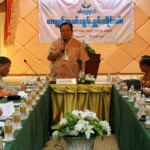By Sai Wansai / Shan Herald Agency for News (SHAN) | April 30, 2018
When Thein Sein-headed Union Solidarity and Development Party (USDP) came into power, following the 2010 nationwide election, people were skeptical what would come out of the civilian-military regime, as the opposition mainstream party like National League for Democracy (NLD) and well known ethnic political party like Shan Nationalities League for Democracy (SNLD) boycotted the election, on ground the Military or Tatmadaw-drafted, 2008 Constitution is either democratic or federal.
Then during Thein Sein’s term, in 2012, the NLD agreed to officially reregister its party, participated in the by-elections and won almost all the seats of some 40 and entered the parliament. From then the military bloc has been able to brush away its international “odd man out” stigma and been riding along the coattail of NLD’s political legitimacy.
Earlier, the NLD won a landslide election victory, capturing 392 seats, in 1990 against the Tatmadaw’s endorsed National Unity Party (NUP), gathering a mere 10 seats; and an ethnic SNLD winning 23 seats, although it only contested in Shan and Kachin States and coming out second nationwide. But the Military never allowed the NLD to take up the government responsibilty and instead opted to embark on decades-long constitutional drafting process.
Then following the 2012 by-elections, the NLD struck a compromise with the Thein Sein government to lobby for the lifting of various sanctions against the country imposed by the West, in return for fair treatment within the parliament. After gradual loosening of the sanctions, President Barack Obama formally announced the lifting of U.S. sanctions on Myanmar in October 2016, which the EU also followed with the exception of the arms embargo. And since then Commander-in-Chief Min Aung Hlaing has been traveling extensively to EU countries, like Germany, Austria, Italy, Belgium and so on meeting military top brass of the countries and visiting armament production facilities, even though the EU arms embargo was still in tact.
But with the mishandling of the Rohingya issue in Rakhine State, the situation changed and these red-carpet treatment of the Commander-in-Chief by the West came to an abrupt end. And the EU, Canada and US slapped targeted sanctions on a Tatmadaw’s commander responsible for the Rakhine State, which now is on the verge of list expansion to include some six more military commanders, according to the recent media reports.
However, the political casualty is not limited to the Tatmadaw alone, as the NLD boss Aung San Suu Kyi, who is now the State Counselor of the country, came to the rescue of the Tatmadaw, rejecting the UN’s ethnic cleansing accusation of the Rohingya mass exodus of some 700,000 across the border into Bangladesh, arguing, using strong language such as “fake rape” and “iceberg of lies”.
The precarious state of the country has now exacerbated into the possible referral to the International Criminal Court (ICC); the UN and its Secretary-General naming of the Myanmar Army or Tatmadaw as being party in the act of sexual violence in par to the accusation of Boko Haram, a radical Islam outfit in Africa; the EU heightened targeted sanctions on Tatmadaw’s commanders; and lately, the U.S. Government conducting an intensive examination of alleged atrocities against Rohingya Muslims, documenting accusations of murder, rape, beatings and other possible offenses in an investigation that could be used to prosecute Myanmar’s military for crimes against humanity, just to name some negative undertakings and a growing list of human rights violations concern by the international community.
Why has the country that Obama used to proudly portray as the sample success of US foreign policy implementation in empowering democratization fallen so steep and so low into what could nearly be termed as a failed state, in just two years after NLD has taken power?
To answer this question, we might have to look into the mindsets and preconceived ideas of the NLD and the Military, who hold the country’s absolute power in hybrid, dual system of civilian-military governance setup.
NLD
To start with, the NLD is seen as a Bamer-dominated party, rather than the nationwide party cutting across ethnic lines, by most non-Bamar ethnic nationalities’ political and civil society organizations of Kachin, Shan, Karenni, Karen, Mon, Ararkan and Chin States.
It is also been viewed as an ethnocentric party with emphasizes on Bamar majority political supremacy ambition and most crucially, the NLD is seen as not genuinely committed to federalism by the ethnic nationalities.
And indeed, the disappointment and doubtfulness on the NLD commitment to federalism and lack of cooperation with the major ethnic parties like SNLD and Arakan National Party (ANP) have lent more negative currency, which could well be understood.
One outstanding example is that despite ethnic parties winning a majority of seats in the Rakhine and Shan assemblies in the 2015 election, the NLD appointed members of its own party as chief ministers in each state. Although the party is able to do this under the constitution, it had previously proposed amending the clause to give state and region hluttaws the power to choose the chief minister.
It should also be noted that the two ethnic parties used to be members of the Committee Representing the People’s Parliament (CRPP), when the NLD was in opposition and under intense suppression by the military regimes of State Law and Order Restoration Council (SLORC) and the State Peace and Development Council (SPDC).
Besides, until today, the party has never made known on what it has in store regarding federalism and never spelled out, in form of a position paper on the subject. It now only hides behind the facade of Nationwide Ceasefire Agreement (NCA)-based peace negotiation process and reasoned the political system setup would depend on the political settlement outcome produced from 21st Century Panglong Conference.
Furthermore, the NLD enacted the Myanmar Hluttaw Committee Law making use of the Myanmar Parliamentary Union (MPU) made up of the speakers and deputy speakers of the Pyithu and Amyotha hluttaws, with the speakers of state and regional assemblies as members. The Pyithu and Amyotha hluttaws’ speakers take the lead and the states’ and regions’ speakers are members. While this kind of exercise is being argued to smooth the relationship between the union central government and the states, regions, the onus is clearly more centralization rather than decentralization, which is the core operation mode in any federal union setup.
Thus, it could be said that the NLD is in mindset ethnocentric and in practice committed to unitary system of governance, perhaps with minimum power devolution and federalism trappings.
Tatmadaw
The Tatmadaw is also the Bamar-dominated army, although its Commander-in-Chief Min Aung Hlaing likes to argue that it encompasses all ethnic groups as its cannon fodders included them but failed to acknowledge that all the military top brass are now Bamar ethnic and not from non-Bamar ethnic nationalities, perhaps with one exception in the past such as General Smith Dunn, who was the Commander-in-Chief from 1948 to 1949. But after the succession by General Ne Win, the ethnic nationalities never rise higher to such height and effectively became a Bamar-dominated military setup.
The Tatmadaw during the first Union Peace Conference – 21st Century Panglong (UPC-21CP), popularly dubbed as 21st Century Panglong Conference (21CPC), under the NLD government on 31 August – 4 September 2016, made known that it considered the military-drafted 2008 constitution has all the necessary features to be turned into a federal union system of governance.
Its position papers delivered during the conference included security and taxation to be considered, among other headings.
Its representative argued that the bicameral House of Nationalities and House of Representatives, plus 14 States and Regions parliaments are the hallmark of federalism, which is embedded in its self-drawn constitution. Furthermore, it pointed out that the separation, checks and balances of legislative, executive and judicial powers are conducive to the formation of a federal union.
It is convinced that the important point in relation to its foreseeable federalism system of governance is the status quo, maintenance of its armed forces and putting more muscles in the organization to achieve its goal of a “standard army”.
It further advocated the implementation of demobilization and reintegration (DDR), which is the dismemberment of the Ethnic Armed Organizations (EAOs) or surrender, rather than the formation of a federal army through security sector reform (SSR), as preferred by the EAOs.
Likewise, it also projected the central role of the union government on taxation, resources management and economy as a whole, and not in a give-and-take consultative manner.
Therefore, it is fair to conclude that the Tatmadaw is for unitary system of government with minimum political power-sharing and the continuation of civilian-military hybrid system. Its statements of willing to employ federalism publicly now and then is just a stunt and have no consistency of wanting to establish a federal union, much less an ethnically equitable one.
Hybrid system, cooperation or power struggle?
The Tatmadaw-drafted constitution of 2008 is in fact a civilian-military hybrid system to empower the Tatmadaw over the civilian elected government.
As all know that the constitution gave the Tatmadaw a 25% non-elected MP seats allotment in all levels of the parliament – upper, lower houses, including states and regions parliaments, including self-administration zones and one self-administration division. This 25% allotted MP seats is instrumental in blocking any constitutional amendment proposal, as the 75% vote ceiling is applied to make changes within the parliament.
And on top of this, the home, defense and border affairs ministries are controlled and managed by the Tatmadaw, according to the prescribed constitution.
Thus, the problematic in democratization process and closely linked peace negotiation process arises in actual implementation of the administrative apparatus.
The NLD has tried once when it was under the Thein Sein regime and again when it came to power to amend the constitution but both attempts shattered, as it was unable to overcome the 75% ceiling hurdle even in its first initiative proposal within the parliament, effectively blocked by the Tatmadaw’s 25% veto power. Its gathering of signature of several millions from the public to call for the constitutional amendment during the Thein Sein tenure wasn’t taken notice by the military bloc, the then governing USPD made up of former military officers and the Tatmadaw.
And again, the ex-President Thein Sein’s directive to the Tatmadaw to observe unilateral ceasefire with the Kachin Independence Army (KIA), endorsed by the parliament in 2013 was not heeded, as the Tatmadaw decided to keep the war flames on for whatever reason it might have in store. This happened despite the fact that Thein Sein was the USDP-installed President.
Because of all these, the hybrid dual system of civilian-military regime couldn’t benefit the democratization and the peace processes and even becomes obstacle to the NLD’s goal-setting.
Analysis
Given such a political backdrop, it could be assumed that the NLD wants more control of the Tatmadaw, unitary system of government with minimum power devolution and strong central control.
The Tatmadaw wants the continuation of hybrid civilian-military system with 2008 constitution intact for unforeseeable future perhaps stretching for decades. Its undertaking of military offensives in Kachin, Shan and now Karen States is an indication of its annihilation policy and zero-sum, win-lose game plan and not for political settlement through political dialogue, which it has shown with the rejection of all-inclusiveness participation of all the EAOs in peace negotiation process.
The ethnic nationalities want an ethnic-territorial-based federal union, including a federal army formation where Security Sector Reform (SSR) would play a decisive role.
As such, the three main actors or stakeholders aspirations seem quite far apart, as values and need satisfactions are very different. Thus, the first task should be to compare and contrast on how the positions could come nearer. And failing this, different ethnic conflict resolution should be considered.
Generally speaking, in ethnic conflict resolution there are two notions that comes into question. One is the weak notion which encompasses differing degrees of self-determination, including confederations, federations, consociational democracies, and unitary states with sub national autonomy – that is, regional parliaments, local governments and so on.
The other is the strong notion or type of outcome, or rather “secession”, that has the most controversial impact on today’s global political landscape, which the existing nation-states stonewall developments in this direction, making use of accepted norms of “non-intervention” and “territorial integrity” to protect their vested interests in preventing dismemberment of their national territories.
“The most comprehensive data set of recent and current violent ethnic conflicts has been compiled by Ted Robert Gurr (in 1993). This data set includes 27 ethnic civil wars that have ended. Of these, twelve were ended by complete victory of one side, five by de jure or de facto partition, and two have been suppressed by military occupation by a third party. Only eight ethnic civil wars have been ended by an agreement that did not partition the country,” according to Chaim Kaufmann in his article “Possible and Impossible Solutions to Ethnic Civil Wars” written in 1996.
And looking at the escalating armed conflict and heightened ongoing military offensives by the Tatmadaw in Kachin and Shan States, with the tendency to expand the conflict into Karen State, given the recent massive military reinforcement, one could conclude it is aiming to resolve the ethnic conflict through military solution aiming for total victory.
Almost all the ethnic nationalities and their resistance forces are for ending the ethnic civil war through an agreement that would not partition the country. But Tatmadaw’s banking on total military victory to resolve the ethnic conflict might propel the non-Bamar ethnic to opt for a more radical approach of “secession”, even though it will be an uphill battle.
“Solutions that aim at restoring multi-ethnic civil politics — such as power-sharing, state re-building, or identity reconstruction—- cannot work because they do nothing to dampen the security dilemma, and because ethnic fears and hatreds hardened by war are extremely resistant to change,” according to Chaim Kaufmann.
And if this is going to be the case, which is now highly likely given the Tatmadaw’s total military victory implementation, civil solution to end the ethnic conflict would become almost impossible, as fears and hatreds hardened by the wars have already starting to be ingrained in the hearts and minds of the ethnic nationalities.
The Tatmadaw could now draw back from its all out military offensives and opt for resolving the conflict through political means for political settlement or continue with its military adventures, which have proven that neither side can win after decades of warfare, and drags down the country into a failed state category.
This article originally appeared on SHAN on April 30, 2018.





![‘The Burma Army Killed Him [Saw O Moo] – At Least the Government or the Army Should Commit to Not Do This Again’: Paul Sein Twa, Executive Director of KESAN](https://www.burmalink.org/wp-content/uploads/2018/05/Saw-O-Moo-commemoration-Paul-Sein-Twa-speaking-2-150x150.jpg)

